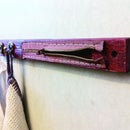Introduction: Steel Plate Hit Detector
This project came to be after doing some long range shooting. I wanted a hit indicator just in case I missed the sound of the bullet hitting the plate and the hit not being visible in the scope, + it's always fun with shiny green lights :) GO!
I started researching and found how I wanted it to work. I had never worked with electronics before but found great inspiration and tips on the web.
I needed a timer function and first I looked at an Arduino solution, but I needed something cheaper (just in case I would accidently but a .308 bullet through the timer unit :)). So I found a great introduction to the IC555 chip and a timer function build made by amandaghassaei here on Instructables.
Step 1: Components & Tools
1. Resistor 0-10KΩ (this resistor is used to control the duration of the light)
2. Resistor 10KΩ
3. Resistor 330Ω
4. Capacitor 470μF
5. Capacitor 0,01μF
6. LED, 5mm round top, ultra bright
7. IC555
8. Piezo element
9. I/O switch
10. Circuit board
11. 9V battery connector
and a LED holder, some wire, shrink tube and a 9V battery. + some 0,75mm2 cable and a box to place the timer unit in.
Tools I used: Multimeter, pliers, soldering iron, solder and a desoldering tool.
Step 2: Bread Board Test
First I built the circuit on a breadboard to get the function right.
When the wires 1 and 2 is crossed the circuit is closed, here's where the piezio element is connected later on.
Step 3: Circuit Board
After that I copied the wiring from the bread board to a circuit board (I had every components X2 so they could remain on the bread board while placing them on the circuit board).
Step 4: Soldering
After mounting the components I soldered them in place.
IMPORTANT, when connecting the battery, make sure to connect + to + and - to -, otherwise you’ll fry the IC555. I made that mistake and was rewarded with a string of grey smoke from the IC555 :-).
Step 5: Assembly
Then I placed the timer unit I the plastic box and attached the piezo element to the 0.75mm2 wire which I then connected to the circuit board inside the box. (My plan was to have the entire unit water resistant but it was hard to find a LED holder within the required IP-class.)
Step 6: Field Testing!
FIELD TESTING! I placed the piezo element in the middle of the steel plate and attached it with duct tape. The plate in this field testing was 15X15cm. I Placed the timer unit a bit behind and off to the side from the plate to minimize the risk of it getting hit with shrapnel.
Evaluation and thoughts. The test went very well but I was just shooting from a distance of 30 meters with a .22 caliber rifle. I hope to test it on 300 meters with a .308 caliber rifle soon. Some times when I hit the plate in the corners the piezo element didn’t detect the hit, but when I placed a shot in the middle there were no problems. My solution to fix this is to parallel connect several piezo elements and place one in each corner of the plate and one in the middle.
When shooting with the 308 I will also put some protection on the wire between the plate and timer unit.
Thanks for reading!













